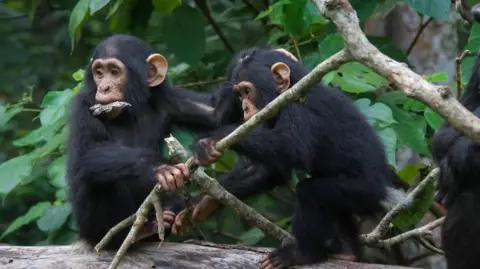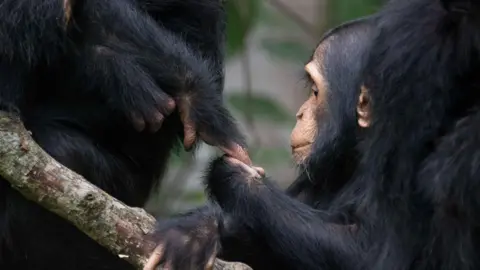 Hobaiter Cat
Hobaiter CatLike humans, wild chimpanzees engage in lively, turn-taking conversations, where they wait just a split second for their turn to “speak.”
Animals communicate primarily through gestures, including hand movements and facial expressions.
Scientists who studied their conversations in detail found that they took “rapid turns” when exchanging information and sometimes interrupted each other.
Revelation suggests ‘deep evolutionary similarities’ [with humans] “In the way face-to-face conversations are structured,” Professor Cat Hobaiter of the University of St Andrews told BBC News.
The results are published in Current Biology journal.
This speed of speech is a hallmark of human conversation, says Professor Hobaiter, who studies primate communication. “We all take about 200 milliseconds between turns of speech, and we show some interesting little cultural variations. Some cultures are ‘fast talkers.'”
A millisecond is one thousandth of a second.
A 2009 linguistic study timed these differences, showing that on average, Japanese speakers took seven milliseconds to respond, while Danish speakers took about 470 milliseconds to chime in.
By examining thousands of examples of wild chimpanzees communicating with each other, Professor Hobaiter and his colleagues were able to time the animals’ conversations.
“It’s amazing how close the interactions between chimpanzees and humans were,” she said.
Chimpanzees have a greater range in their conversation timing. “The intervals ranged from the signaller interrupting 1,600 milliseconds before the signaller finished, to 8,600 milliseconds before responding,” says Professor Hobaiter.
“This could be because the chimpanzees were in a natural environment, which allowed them to express a wider range of behaviors – sometimes interrupting each other and sometimes taking a long time to respond.”
 Hobaiter Cat
Hobaiter CatAs part of their research into the evolutionary origins of communication, the researchers spent decades observing and recording the behavior of five communities of wild chimpanzees in the forests of Uganda and Tanzania.
They recorded and translated more than 8,000 gestures from more than 250 individual animals.
Dr Gal Badihi, lead researcher at the University of St Andrews, explained that the gestures allowed the chimpanzees to avoid conflict and coordinate with each other.
“So one chimpanzee might signal to another that it wants food, and the other might give it food or, if it feels less generous, respond by signaling it to move away.
“They can agree on how and where to groom each other. It’s fascinating and it’s done with a few short exchanges of gestures.”
He said future studies examining communication in other primate species more distant from us will give us a more complete evolutionary picture of why we adopted this rapid turn-taking dialogue.
“This will be a great way to better understand when and why our conversation rules evolved,” he said.




